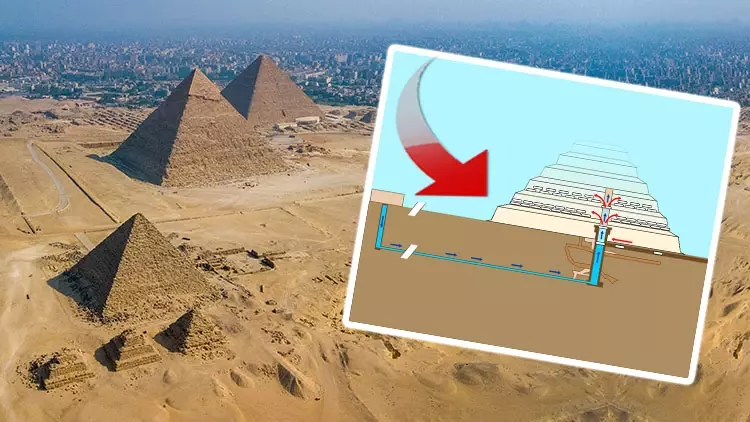In a groundbreaking revelation that challenges long-held beliefs, archaeologists have discovered an advanced water management system around the Pyramid of Djoser, suggesting that the ancient Egyptians employed sophisticated hydraulic technology in their monumental construction efforts.
IN A NUTSHELL
- 🌊 Researchers discovered an advanced water management system around the Pyramid of Djoser, showcasing ancient Egyptian engineering prowess.
- 🏗️ The system included a vast stone dam that captured and stored floodwaters, supporting large-scale construction projects.
- 🔧 An intricate hydraulic lifting system beneath the pyramid utilized water pressure to elevate limestone blocks efficiently.
- 🔍 This discovery redefines our understanding of ancient Egyptian technological innovation and prompts a reevaluation of historical construction methods.
The ancient pyramids of Egypt have long fascinated historians, archaeologists, and enthusiasts alike, drawing them into a world of mystery and architectural brilliance. Recently, a groundbreaking discovery has emerged, offering a fresh perspective on how these monumental structures were built. The presence of an extensive water management system around the Pyramid of Djoser has prompted archaeologists to reconsider the construction techniques of the ancient Egyptian builders, revealing a technological prowess that far surpasses previous assumptions.
A Stone Dam to Capture and Store Desert Floodwaters
In the heart of Saqqara, a monumental stone structure known as Gisr el-Mudir has intrigued researchers for years. Measuring nearly 1,181 feet long, this rectangular enclosure is one of Egypt’s oldest stone constructions. Recent studies by Xavier Landreau and his team at the CEA Paleotechnic Institute, published in the scientific journal PLOS ONE, suggest that this structure was not a ritual enclosure or defensive wall as previously thought. Instead, it functioned as a dam, capable of capturing floodwaters from nearby wadis.
By analyzing the region’s slopes, ancient watercourses, and erosion marks, researchers reconstructed a watershed capable of channeling water to the enclosure. This structure likely served as a temporary reservoir, holding up to 105 million gallons of water—a volume sufficient to support extensive construction projects. During seasonal floods, the captured water would also deposit sediments into a series of natural basins downstream.
This discovery repositions Saqqara’s role in Egyptian history, suggesting that its location was chosen not only for religious or political reasons but also based on geological and hydrological criteria. As noted by Armées.com, this new interpretation unveils a previously unrecognized land management strategy for the era.
How Hydraulic Construction of the Pyramids Worked
While ample water storage upstream was essential, it was not enough to lift limestone blocks. The key lay in the depths of the Djoser complex. South of the monument lies a vast trench carved into the rock, featuring a series of interconnected basins and compartments. This network, known as the “Deep Trench”, operated as a water treatment system. Heavier sediments settled first, gradually clarifying the water before it was transferred further.
This purified water likely powered a vertical lifting system beneath the pyramid. Two vertical shafts, connected by a 656-foot underground gallery, enabled the installation of a floatation device. Blocks placed on a floating platform could be elevated by the simple pressure of water injected into the shafts. Once the load reached the desired height, it was slid onto the monument’s upper levels.
The observed structures within the galleries, underground compartments, and pyramid conduits support this hypothesis. Some granite elements, previously thought to have funerary functions, actually exhibit characteristics of a flow-regulation and sealing system. The entire setup functioned much like a hydraulic elevator, using water’s force to minimize mechanical effort.
A Sophisticated Technology Befitting Pharaonic Ambitions
Though the hydraulic construction hypothesis may seem bold, it rests on concrete field observations. The dam, basins, galleries, and shafts all exhibit a logical organization compatible with a hydraulic chain. Contrary to popular belief, the Egyptians already mastered many water-related techniques. Irrigation canals, wooden sluices, agricultural dams—all testify to their well-established hydraulic expertise.
The study goes further, showing that this system avoided the need for immense external ramps, significantly reducing labor requirements and logistical constraints. The project thus became more efficient, safer, and precise. While this method doesn’t entirely rule out the use of ramps, it offers a complementary, credible, and ingenious solution.
This level of engineering, advanced for its time, prompts researchers to reconsider other Old Kingdom monuments. The Pyramid of Djoser, often viewed as a prototype, could actually have been the product of a highly developed technology that subsequent dynasties failed to replicate.
What the Hydraulic Remains at Saqqara Change in Our Understanding of the Past
Until now, pyramids have been predominantly studied from symbolic or architectural perspectives. The discovery of such an expansive and integrated hydraulic system opens up a new avenue. It demonstrates that the builders did not merely respond to a religious project; they also conceived a sustainable technical ecosystem, adapted to the environment and available resources.
This interdisciplinary approach, combining archaeology, hydrology, and geotechnics, enriches our understanding of the past. It reveals a sophisticated work organization, rigorous material management, and fine territorial exploitation. It’s now plausible to imagine that pyramids were not solely the result of massive labor mobilization but also an underappreciated technical genius.
This perspective highlights the innovative capabilities of ancient Egypt and invites a new examination of other monumental sites, searching for similar traces of buried or forgotten hydraulic systems.
The revelation of Egypt’s ancient hydraulic mastery not only reshapes our understanding of pyramid construction but also sheds light on the broader technological landscape of the time. As we delve deeper into these ancient systems, we must ask: What other forgotten technologies might be waiting to be rediscovered beneath the sands of history?
This article is based on verified sources and supported by editorial technologies.


